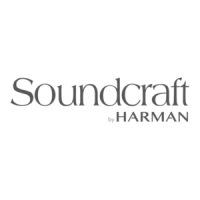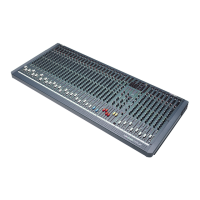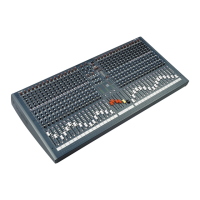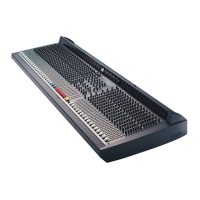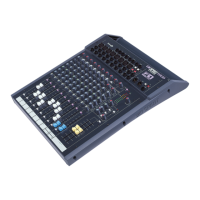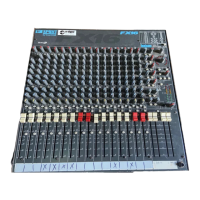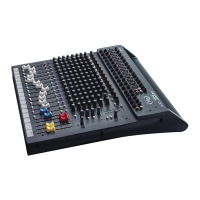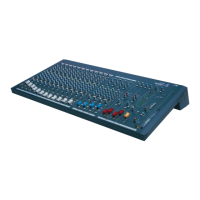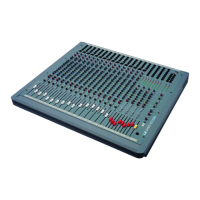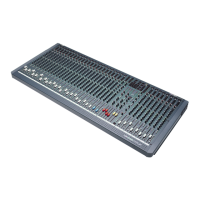
Do you have a question about the SoundCraft SPIRIT LIVE 42 and is the answer not in the manual?
| Brand | SoundCraft |
|---|---|
| Model | SPIRIT LIVE 42 |
| Category | Music Mixer |
| Language | English |
Explains the fundamental purpose and components of the mixer, including inputs, outputs, and controls.
Details the function and operation of the mixer's equalizer controls for frequency adjustment.
Describes how auxiliary sends route signals for foldback, effects, or additional outputs.
Explains the pan control's function for positioning signals within the stereo mix.
Details the PFL function for monitoring individual signals without affecting the main mix.
Explains the insert point for connecting external signal processing units to channels.
Explains the concept of headroom and its importance in preventing clipping and noise.
Provides guidance on proper mixer placement, cabling, and connection for optimal operation.
Outlines essential safety measures to ensure user safety and prevent equipment damage.
Illustrates how to connect microphone-level audio sources to the mixer inputs.
Shows the connection of stereo audio sources like keyboards and playback devices.
Details how to connect line-level audio sources to the mixer.
Explains the proper wiring for balanced and unbalanced microphone connections.
Details wiring for line-level inputs, including balanced and unbalanced configurations.
Describes the wiring for the insert point on input channels for external processing.
Covers stereo inputs and dedicated Cass/CD inputs for various audio sources.
Explains the use of stereo returns for effects units or external sources.
Details insert points for Mix and Group outputs for signal processing.
Explains connections for Mix, Group, and Matrix outputs, including balanced options.
Describes Aux outputs and Direct outputs for routing and multitrack recording.
Details the headphone output jack and recommended headphone impedance.
Explains signal polarity and phase concepts for balanced audio connections.
Provides essential guidelines for grounding and shielding to minimize noise and interference.
Offers basic troubleshooting advice, focusing on understanding the block diagram and signal flow.
Outlines a logical process for diagnosing and resolving common mixer issues through elimination.
Provides a detailed explanation of the mono input channel, its inputs, and controls.
Explains the +48V phantom power feature for condenser microphones and its precautions.
Details the phase switch and input sensitivity control for optimizing signal levels.
Describes the hi-pass filter for reducing low-frequency rumble and hum.
Details the four-section equalizer controls, including HF, LF, and Mid-frequency adjustments.
Explains the EQ switch for bypassing the equalization section for comparison.
Details how auxiliary sends are configured (pre/post fade) for different routing needs.
Explains pan control for stereo imaging and routing switches for group/mix assignment.
Describes the function of the 100mm long-throw fader for channel level control.
Explains how to mute channels individually or via mute buses.
Details the PFL switch for monitoring and the PEAK LED for overload indication.
Covers the function of stereo inputs and dedicated inputs for cassette or CD players.
Explains the gain switch for selecting input sensitivity for Cass/CD sources.
Details auxiliary sends for stereo input channels, providing mono sums.
Explains PFL for stereo channels and the level control for the stereo mix.
Details gain adjustment and equalizer controls for stereo input channels.
Explains the EQ switch and auxiliary sends for stereo input channels.
Describes the balance control for adjusting the stereo image of the input signal.
Details routing switches for stereo signals to Mix or Group busses.
Explains the fader and muting functions for stereo input channels.
Details the PFL switch for monitoring stereo input signals.
Describes the faders for controlling the output level of the Group busses.
Explains routing Groups to the stereo Mix and mono options.
Details how Group signals can be sent to Matrix outputs for additional mixes.
Explains the use of stereo returns for effects or external sources to Groups.
Describes the 12-segment bargraph meters for monitoring Mix and Group levels.
Explains the final level control for the Mix outputs.
Details sending signals to Matrix outputs and controlling their master levels.
Explains the talkback microphone input and routing options.
Describes the power status LEDs on the console.
Details the master level controls and AFL switches for Auxiliary send busses.
Explains the LED that indicates when PFL or AFL monitoring is active.
Covers the headphone level control and the mono check function for phase issues.
Explains mute master controls and the headphone output jack.
Provides advice on optimal microphone placement for sound reinforcement.
Guides users through the initial setup process for the mixer controls and levels.
Provides essential precautions for storing, cleaning, and maintaining the mixer.
Details the noise performance metrics for various mixer outputs.
Specifies the frequency response range of the mixer.
Provides specifications for Total Harmonic Distortion (THD).
Details the Common Mode Rejection Ratio (CMRR) for inputs.
Lists the input and output impedance values for various connections.
Specifies the nominal and maximum input/output signal levels.
Provides the physical dimensions of the mixer console.
Explains how the console can be mounted in a flight case.
